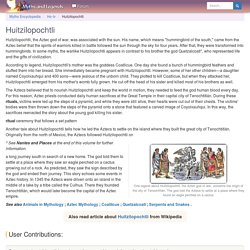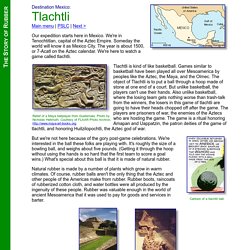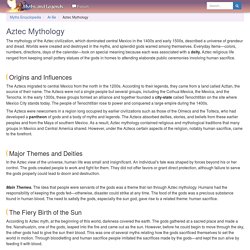

Huitzilopochtli - Myth Encyclopedia - mythology, god, story, legend, war, world, life, children. Huitzilopochtli, the Aztec god of war, was associated with the sun.

His name, which means "hummingbird of the south," came from the Aztec belief that the spirits of warriors killed in battle followed the sun through the sky for four years. After that, they were transformed into hummingbirds. Mythological Journey to the Aztec Underworld. In Aztec (also called Mexica) cosmology, the soul’s journey to the Underworld after death leaves them with four destinations: the Sacred Orchard of the Gods, the Place of Darkness, the Kingdom of the Sun, and a paradise called the Mansion of the Moon.

The most common deaths end up on their way to Mictlán (Place of Darkness) with its nine levels, crashing mountains and rushing rivers, and four years of struggle. This pantheon of gods and goddesses and the expanse of the 13 Heavens provides the cultural basis for the Day of the Dead customs and celebrations. Based on a post by Moctezuma Xocoyotzin, Published by Zoe Saadia at Pre-Columbian Americas. Tlachtli. Destination Mexico: Tlachtli Main menu | PSLC | Next > Our expedition starts here in Mexico.

We're in Tenochtitlan, capital of the Aztec Empire. Someday the world will know it as Mexico City. Aztec Monsters – Mexico Unexplained. Podcast: Play in new window | Download Subscribe: Apple Podcasts | The Aztec Empire was a living and breathing political entity dominating central Mexico when Europeans first encountered it in 1519.

Cortés and his band of Spanish conquistadors entered the Aztec capital of Tenochtitlán as invited guests of the Emperor Montezuma. They stayed in the capital for many months before things went south. Aztec Mythology - Myth Encyclopedia - god, story, legend, names, ancient, animal, snake, war, world, creation. The mythology of the Aztec civilization, which dominated central Mexico in the 1400s and early 1500s, described a universe of grandeur and dread.

Worlds were created and destroyed in the myths, and splendid gods warred among themselves. Everyday items—colors, numbers, directions, days of the calendar—took on special meaning because each was associated with a deity. The 8 Most Important Gods and Goddesses of the Aztec Empire. In 1325 AD, the Aztec people moved to an island in Lake Texcoco to set up their capital, Tenochtitlán.

The story goes that they saw an eagle holding a rattlesnake in its talons, perched on a cactus. Believing this vision was a prophesy sent by the god Huitzilopochtli, they decided to build their new home on that exact site. And so the city of Tenochtitlán was founded. To this day, this story of their great migration from their legendary home of Aztalan is pictured on the coat of arms of Mexico. Aztec Mythology - Myth Encyclopedia - god, story, legend, names, ancient, animal, snake, war, world, creation. The mythology of the Aztec civilization, which dominated central Mexico in the 1400s and early 1500s, described a universe of grandeur and dread.

Worlds were created and destroyed in the myths, and splendid gods warred among themselves. Everyday items—colors, numbers, directions, days of the calendar—took on special meaning because each was associated with a deity. Aztec feast in an illustration taken from the History of the Indies... Photo d'actualité. Aztec, Ancient aztecs, Aztec society. What Did the Aztecs Eat and Drink? Mexican Food of the Middle Ages. The Aztec civilisation, which flourished in the 14th century until the fall of the Aztec Empire in 1519, was a society based around agriculture.

Most Aztecs would spent their days working their fields or cultivating food for their great capital city of Tenochtitlan. Since it was easier to grow crops than hunt, the Aztec diet was primarily plant-based and focused on a few major foods. Maize, beans, salt and chilli peppers were the constants of Aztec cuisine, providing the average Aztec with a well-rounded diet without major deficiencies in vitamins and minerals. Daily meals Most Aztecs ate twice a day: the first after a few hours of morning work, and the second during the hottest hour of the day: at around 3 o’clock. Aztec Family Law - Exhibit - Aztec and Maya Law - Tarlton Law Library at Tarlton Law Library. Aztec Song. The following article has been generously written for us by Dr.

Frances Karttunen, retired Professor of Linguistics and Senior University Research Scientist, Linguistics Research Centre, University of Texas, prolific author and expert on the Náhuatl language. The words to hundreds of Aztec songs and fragments of songs are preserved to this day in two manuscripts with Spanish titles that were written soon after the Spanish Conquest.
One is called Cantares Mexicanos, which has been translated from the Spanish as “Songs of the Aztecs.” Aztec Music - Cantares Mexicanos. Aztec Drum Rhythms- making music with syllables and fractions - Welcome to my virtual field trip on Aztec music!

It includes: 1) a brief description of Aztec instruments; 2) a video of Phil's "Cantares Mexicanos Rhythms" music lesson with shakers, 3) a guide to translating Aztec drum syllables into musical notation, 4) recreations of Aztec drum rhythms and music, and 5) multimedia activities that combine Aztec drumming with other areas of the curriculum! So, take a couple of minutes to read more about Aztec culture, learn how to vocalize some rhythms using Aztec drum syllables, and explore some surprisingly fun connections we can make between language, math, and music! Aztec Instruments The Aztecs used a variety of wind and percussion instruments to make music. Aztec Empire for Kids: Art. History >> Aztec, Maya, and Inca for Kids Art was an important part of Aztec life.
They used some forms of art such as music, poetry, and sculpture to honor and praise their gods. Other forms of art, such as jewelry and feather-work, were worn by the Aztec nobility to set them apart from the commoners. Metaphors. Aztec, New Mexico Population 2021 (Demographics, Maps, Graphs) Aztec is a city located in New Mexico. With a 2020 population of 6,197, it is the 29th largest city in New Mexico and the 4243rd largest city in the United States. Aztec is currently declining at a rate of -1.37% annually and its population has decreased by -8.37% since the most recent census, which recorded a population of 6,763 in 2010. Aztec reached it's highest population of 6,747 in 2010. Spanning over 13 miles, Aztec has a population density of 492 people per square mile.
The average household income in Aztec is $56,220 with a poverty rate of 21.61%. Aztec, NM. Aztec Emperors (Huey Tlatoani) The Aztec Empire was a civilization in central Mexico that thrived in the time before the arrival of European explorers during the Age of Exploration. Throughout its history as a civilization the Aztec Empire expanded across much of central Mexico and other surrounding areas, to become the most dominant and powerful people in the region. Tenochtitlan was the center of this vast empire. Mesoamerican city-states or ‘altepetl’ (as they were referred to as in the Aztec language of Nahuatl) were the basic structure of the Aztec Empire. Aztec Empire for Kids: Government and Empire.
History >> Aztec, Maya, and Inca for Kids Empire The Aztec Empire was made up of city-states. At the center of each city-state was a large city that ruled the area. For the most part, the Aztec Emperor did not interfere with the ruling of the city-states. Rituals - Ancient aztec religion. Blood-letting was a ritual, where people would cut themselves to offer their blood to the gods. The Aztecs had 18 months in a cycle and for each of the 18 months there was a ritual sacrifice. The victim would be painted as part of the ritual. In Mesoamerica, sacrifice was a religious ritual. Aztec Religion. Aztec writing, Aztec symbols, Mayan symbols. Nahuatl language, pronunciation and alphabet. Nahuatl. What Was the Climate Like Where the Aztec Lived? eCUIP : The Digital Library : Science : Cultural Astronomy.
Aztec human sacrifice was a bloody, fascinating mess.